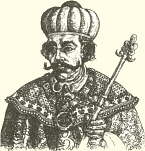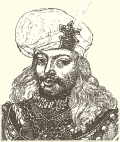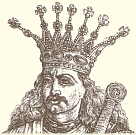
Bram Stoker found inspiration for his book about Count Dracula in the life of Vlad III the Impaler of Walachia (±1431-1476). Contemporaries wrote about the "untold abuses, sad murders and mutilations by the cruel tyrant Dracula" 1.
He had people skinned alive up to their entrails, or roasted upon red-hot coals, but this psychopath's favourite method of torture was impalement. Once, when Vlad walked along the twitching bodies dying on their stakes, he is supposed to have exclaimed: "How beautiful they look!"
Thus, Vlad Dracula became known as "Vlad Tepes" - "Vlad the Impaler".

Vlad III Dracula was a son of Vlad II Dracul (to the right), voivode of Wallachia in present-day Romania.
The nickname "Dracul" means either "devil" or "dragon". His devilish nickname could also have been earned by his clever political manoeuvring; early 1431, Vlad II was invested with the Order of the Dragon by the Holy Roman Emperor. In the Romanian language the "-ulea" ending of a word is used for "the son of",
Vlad II Dracul may have married a daughter of Alexandru the Good of Moldavia around 1425. She may have been the mother of his eldest son, Mircea (1428-1447). When Vlad Dracul was in exile in Sighisoara in Transylvania,
his son Vlad was born "under the sign of the scorpion", probably in 1431. Young Vlad's mother was probably one of Vlad II's many mistresses. Another brother, Radu cel Frumos (†1471), was born in 1435. A boyar's daughter with the name Caltuna was the mother of yet another brother, Vlad Calugarul the Monk (†1496). In medieval Wallachia the status of women was low and illegitimate sons were allowed to inherit.
Wallachia was ruled by voivodes and they were usually members of the Basarab family. In the absence of progeniture in Slavic law, the Draculi line of the Basarabs fought a bloody feud with their cousins of the Danesti line. Officially, they were vassals of the King of Hungary, but they were also forced to pay tribute to the Ottoman sultans.
In 1436, Vlad II succeeded in regaining the throne of Wallachia after the death of his half-brother, Alexandru Aldea, and reigned for six years, until he had to flee his country again. With help of the Ottomans, Vlad II was back on the throne in 1443.
 He was obliged to send his two younger sons, Vlad Dracula and Radu, to the Sultan as hostages. The boys were taken to the fortress of Egrigöz in the forests of Anatolia. Although they were not actually confined to a cell, they had a lot to fear.
He was obliged to send his two younger sons, Vlad Dracula and Radu, to the Sultan as hostages. The boys were taken to the fortress of Egrigöz in the forests of Anatolia. Although they were not actually confined to a cell, they had a lot to fear.
To spare his younger sons, Vlad II did not take part in the following campaigns against the Ottoman Turks, but let his eldest son, Mircea, lead the Wallachian armies. In 1445, Mircea recaptured the fortress at Giurgiu and had the prisoners hacked to death. Later, when Vlad II signed a new treaty with the Sultan, he had to abandon the fortress of Girugiu to keep Wallachia independent and his younger sons safe. In November 1447, the Hungarian János Hunyadi launched an attack on Wallachia with the intention to replace Vlad II with Vladislav of the Danesti Line. While Hunyadi attacked, the boyars of Tirgoviste revolted and captured Mircea, who was tortured, blinded with red-hot irons and buried alive. Vlad II managed to escape, galloping east. Somewhere in the marches near present-day Bucharest, however, the rebels caught up with him. He was decapitated with an axe.
Vlad III Dracula was still a prisoner of the Ottoman Sultan, when news of his father's and brother's deaths reached him by the end of 1447. He was officially freed from his position as hostage and given a rank in the Ottoman army
5. In September 1448, Hunyadi and Vladislav Danesti were captured by the Ottomans near Kosovo. With an Ottoman army, Vlad Dracula, although still a teenager, invaded Wallachia and took Tirgoviste unopposed. Vladislav Danesti escaped, but when he returned with an army,
 Mehmed, the new Ottoman sultan, finally conquered Constantinople in 1453, and the Eastern Roman Empire ceased to exist. When Vladislav Danesti befriended the new Sultan,
a reconciliation took place between János Hunyadi (to the right) and Vlad Dracula. In Buda, Vlad attended the coronation of Ladislas V of Habsburg as King of Hungary, and was invested as defender of Transylvania with headquarters at Sibiu. In 1456, Hunyadi invaded Serbia, while Dracula simultaneously invaded Wallachia. He led his army through the Carpatians in June,
when the Comet of Halley appeared in the sky7. By the end of July, Vladislav Danesti had died in battle. According to legend, he was hacked to death in a hand-to-hand combat with Vlad Dracula. On August 22, 1456, Vlad was ruler in Tirgoviste.
Mehmed, the new Ottoman sultan, finally conquered Constantinople in 1453, and the Eastern Roman Empire ceased to exist. When Vladislav Danesti befriended the new Sultan,
a reconciliation took place between János Hunyadi (to the right) and Vlad Dracula. In Buda, Vlad attended the coronation of Ladislas V of Habsburg as King of Hungary, and was invested as defender of Transylvania with headquarters at Sibiu. In 1456, Hunyadi invaded Serbia, while Dracula simultaneously invaded Wallachia. He led his army through the Carpatians in June,
when the Comet of Halley appeared in the sky7. By the end of July, Vladislav Danesti had died in battle. According to legend, he was hacked to death in a hand-to-hand combat with Vlad Dracula. On August 22, 1456, Vlad was ruler in Tirgoviste.
Soon, Vlad Dracula tried to strengthen and modernise the central government at the expense of the nobility, because they had repeatedly undermined the power of the voivodes. Early in his reign, he gave a feast for his boyars and their families to celebrate Easter. Since many of them had taken part in the conspiracy that led to the deaths of his father and elder brother, Vlad asked them how many voivodes had ruled during their life times. All of the nobles said they had outlived several voivodes. The older boyars and their families were impaled on the spot, while the younger and healthier boyars were enslaved and forced to labour for months building Castle Dracula. Very few of them survived the ordeal. One boyar, Albu cel Mare, was over-mighty and arrogant. He took the villages of Glodul and Hintea by force, and devastated the monastery of Govora. Vlad had him and his allies and relations, including small children, impaled. Of the 13 names of the boyars of the council of April 16, 1457, only 2 remained in February 10, 1461. Vlad Dracula's reign of terror had begun.
Castle Dracula was built on a mountain peak to the north of the city of Curtea-de-Arges, using materials from the ruins of an earlier castle. In 1459, near a series of connected villages, Vlad Dracula founded the fortress of Bucharest, the present-day capital of Romania. He also built small mountain fortresses at various strategic frontier points. Vlad was the first to name a native clergyman as metropolitan of the Wallachian Orthodox Church.
In 1461, he had a church completed at Tirgsor 8 and a monastery founded at Comana. He greatly extended the monastery at Snagov.
Vlad Tepes was not very tall, but stocky and strong, with a bull's neck, broad shoulders, a reddish face, an aquiline nose, large, deep-set, green eyes, long eyelashes and bushy black eyebrows, which gave him a threatening appearance. His chin was shaven, but he had a large moustache. His personality was cruel, haughty and authoritarian, and he was rash and reckless and lacked empathy or remorse. Once, Ottoman envoys refused to honour him by taking their turbans off, because they were forbidden by their religion to remove them. Vlad is said to have ordered their turbans to be fixed with nails to their heads, so that they could never take them off.
German merchants and craftsmen from Saxony had colonised Transylvania in the 12th and 13th century. Their skills had given a significant impulse to economic life in the region and, as a result, the Saxons had a great measure of autonomy. Early in his reign, Vlad Dracula tried to maintain a cordial relationship with the Saxon towns, while they provided soldiers for the wars against the Turks. In the summer of 1457, however, citizens of Bistrita revolted over alleged abuse of funds. Mihail Szilágyi, a relative of Hunyadi, sacked the town and burned the houses of the ringleaders. Other Saxon cities started plotting with Vlad's rivals of the Danesti line and Vlad's half-brother, Vlad Cugarul. In the spring of 1458, Vlad Dracula undertook a devastating raid on the merchants. The villages of Satul Nou, Hosman and Casolts were burned to the ground, while the people of Talmes were, 'like cabbage', hacked to pieces in the town square. Later that year, Szilágyi negotiated a peace between Vlad and the Saxons. In exchange for the surrender of the pretender,
Dan III9, and his boyar followers, Vlad promised to restore the merchants' trading rights.
When Dan Danesti and his boyars were not forthcoming, Vlad, attacking at night, hit the suburbs of Brasov
10 like a whirlwind. Its inhabitants were impaled in large numbers, while "The Impaler" sat eating at a table in the open air, overlooking his victims. When he noticed that one of his boyars was holding his nose in an effort to alleviate the terrible smell, Vlad had the sensitive noblemen impaled on a stake higher than all the rest
"so that he might be above the stench". Vlad also looted and burned the churches of St. Jacob and St. Bartholomew, carrying away its holy relics. At first, Dan had fled. Soon, he launched a counter-offensive, but lost the battle. Dan was captured and forced to dig his own grave. It was said that Vlad hacked off his rival's head himself. Finally, Brasov concluded a treaty with Vlad Tepes on October 1, 1460.
Vlad Dracula used all kind of methods of torture and execution, like nails in heads, scalping, cutting off of limbs, noses, ears and breasts, blinding, strangulation and skinning, burning, roasting and boiling alive, exposure to wild animals or mutilation of sexual organs. Impalement, however, was Vlad's preferred method. Death by impalement was slow and painful. Victims sometimes endured for hours or days. Usually an horse was attached to each of the victim's legs and a sharpened stake was gradually forced into the body. The end of the stake was usually oiled and care was taken that the stake was not too sharp; so that the entrails of the victims should not be pierced by a wound too immediately fatal. 'Normally', the stake was inserted into the body through the anus or vagina and the stake was then hoisted upright. Thus, the victim was slowly impaled by the force of his own weight. Often, victims were impaled through other bodily orifices or through the abdomen or chest. Sometimes the victim was impaled upside down. The height of the stake indicated the rank of the victim. Vlad Dracula often arranged the stakes in various geometric patterns. The most common pattern was a ring of concentric circles in the outskirts of the city that was his target. The decaying corpses were often left up for months. Vlad's victims included women and children, peasants and great lords and even ambassadors from foreign powers. Often hundreds were impaled at a single time.
Vlad Dracula tried to enforce his own moral code upon his country and was particularly concerned with female chastity. Maidens, who had lost their virginity, adulterous wives and unchaste widows often had their sexual organs cut out or were impaled through the vagina on red-hot stakes. He also ordered the breasts of women to be cut off and he forced their men to eat them. He would roast little children and force their own mothers to eat them. It was reported that Vlad once ripped open the body of one of his mistresses to disprove her pregnancy.
Vlad was also 'concerned' with the numerous poor, vagabonds, beggars and cripples in his land, explaining:
"These men live off the sweat of others; it is a form of thievery." He invited them to come to Tirgoviste for a fabulous feast and when they had ate and drank late into the night, he had the doors locked and the hall set on fire - and none escaped the flames. Thus Dracula 'eradicated poverty'.
According to legend, Vlad had a big, copper cauldron, with a wooden lid with holes in it, filled with water. People were put in the cauldron with their heads in the holes, and a fire was kindled under it. The people cried and screamed until they were burned or cooked to death. On another occasion, a condemned gypsy leader protested that death by impalement or fire was contrary to the law of his tribe. Vlad ordered him to be boiled alive in the cauldron, and compelled the members of this tribe to eat his flesh.
 Early in his reign, Vlad Dracula had send emissaries to the Ottoman Sultan and paid tribute to keep him at arm's length. The annual tribute consisted of 10000 ducats and 500 boys. In 1461, Vlad explained in a letter that he had no more resources and could not leave Wallachia at that precarious time. Next, Vlad attacked and burned an Ottoman stronghold and 2 crossing points of the Danube. Nearly 24000 heads of Turks and Bulgarians were presented to the officials.
Vlad send emissaries to Hungary 11 and the Crimea for support, but he was abandoned by his allies.
Even Stephan cel Mare of Moldavia (to the right), who had acquired his throne in 1457 with help from Vlad, took the side of the Ottomans. Vlad had always been impulsive and reckless, but his attack on the Ottomans was foolhardy in the extreme.
Early in his reign, Vlad Dracula had send emissaries to the Ottoman Sultan and paid tribute to keep him at arm's length. The annual tribute consisted of 10000 ducats and 500 boys. In 1461, Vlad explained in a letter that he had no more resources and could not leave Wallachia at that precarious time. Next, Vlad attacked and burned an Ottoman stronghold and 2 crossing points of the Danube. Nearly 24000 heads of Turks and Bulgarians were presented to the officials.
Vlad send emissaries to Hungary 11 and the Crimea for support, but he was abandoned by his allies.
Even Stephan cel Mare of Moldavia (to the right), who had acquired his throne in 1457 with help from Vlad, took the side of the Ottomans. Vlad had always been impulsive and reckless, but his attack on the Ottomans was foolhardy in the extreme.

Copyright © 2005-2007 by J.N.W. Bos. All rights reserved.
1 In Germany Vlad Dracula has been described as an inhuman tyrant who sadistically butchered innocents, but in Communist Eastern Europe Vlad was regarded as a brave Prince, who defended Christendom against the Ottoman onslaught, and imposed strong leadership and harsh justice toward the greater good of the Romanian people.
2 All of Vlad II's sons were known by the nickname "Dracula".
3 Stephan and Gregor Brankovic were brutally blinded, despite the fact that their beautiful sister Mara was one of the Sultan's wives.
4 When Mehmed first tried to seduce Radu, the boy cut Mehmed with his sword and then, in fear for his life, ran and climbed up a tree. Mehmed only talked him into coming down by promising not to kill him.
5 Vlad may have become a member of the Jannissary Corps, which was made up of foreigners.
6 Bogdan was a son of Alexandru the Good of Moldavia; his sister may have been married to Vlad II.
7 For more than 7 weeks the comet could be seen in central and eastern Europe: "as long as half the sky with two tails, one pointing west and the other east, colored gold and looking like an undulating flame in the distant horizon".
8 This may have been in celebration of his nearby victoriy over Vladislav Danesti.
9 Dan III was a brother of Vladislav Danesti.
10 The city of Brasov was also known as Kronstadt.
11 He send the Hungarian King 2 bags full of Turkish heads.
12 Vlad stuck stakes in both the mothers breasts and thrust their babies unto them.
13 Matthias Corvinus' mother was a sister of Michael Szilágy and Ilona was Michael's daughter.
14 Stephan Bathory (1533-1585) was an uncle of the notorious Erzsébet Bathory (±1561-1614).
15 Some reports indicate that Vlad Dracula was slain by a hired assassin or even one of his own men.
16 Within the short span of his 6-year rule, the estimated number of Vlad's victims ranges from 40,000 to an unlikely 100,000 people.
Content: